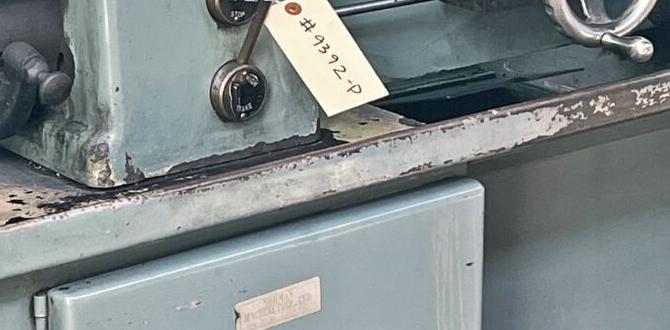Bolded Quick Summary
For plunge milling polycarbonate, the TiAlN ball nose end mill at a 35-degree helix angle is essential. This specialized tool provides superior chip evacuation and heat resistance, preventing melt-down and ensuring clean cuts in this unique plastic.
Working with plastics like polycarbonate on a milling machine can be a real head-scratcher, especially when you need to plunge straight down into the material. It’s easy to overheat, stick, and end up with a gummy, melted mess instead of a clean cut. This is where the right tooling makes all the difference. Today, we’re diving into why a specific type of end mill – the TiAlN ball nose end mill with a 35-degree helix angle – is your go-to solution for plunge milling polycarbonate. We’ll break down what makes it special and how to use it effectively, so you can tackle those projects with confidence.
Understanding Polycarbonate and Plunge Milling Challenges
Polycarbonate is a fantastic material. It’s incredibly strong, impact-resistant, and surprisingly lightweight. You’ll find it used in everything from safety glasses and CDs to aircraft windows and machine guards. However, when it comes to machining, it presents some unique challenges, especially with plunge milling.
Plunge milling, also known as drilling or peck drilling with an end mill, involves driving the tool straight down into the workpiece. For most metals, this is a standard operation. But polycarbonate, being a plastic, has a low melting point and tends to gum up tools. When an end mill plunges, it generates concentrated heat right at the tip. Without proper heat dissipation and chip removal, the polycarbonate can soften, melt, and weld itself to the cutting edges of the tool. This leads to:
- Tool binding and breakage
- Poor surface finish in the hole
- Overheating of the workpiece
- Inconsistent cut quality
Traditional end mills, especially those designed for harder materials like steel or aluminum, often struggle. They can’t effectively clear the softened plastic chips away from the cutting zone, trapping heat and causing the dreaded melt-down. The key is to find a tool that can cut cleanly, manage heat, and get those chips out of the way fast.
Why a Ball Nose End Mill?
A ball nose end mill, as the name suggests, has a rounded tip – a perfect hemispherical shape. This is crucial for plunge milling applications for a few reasons:
- Smooth Entry: The rounded profile allows for a smoother, more gradual engagement with the material compared to a flat-end mill. This reduces the initial shock and heat buildup at the very center of the cut.
- Radius for Strength: The radius at the tip adds structural integrity, making it less prone to chipping compared to a sharp corner found on a square end mill.
- Versatile Machining: While we’re focusing on plunge milling, ball nose end mills are also fantastic for creating rounded internal corners, fillets, and 3D contoured surfaces.
For plunge milling, the ball shape helps distribute the cutting forces more evenly as the tool descends, contributing to a cleaner entry than a flat-bottomed tool. This means less stress on both the tool and the material.
The Importance of the TiAlN Coating
Even with a ball nose shape, the heat generated during plunge milling polycarbonate can be immense. This is where the coating on the end mill becomes a game-changer. TiAlN stands for Titanium Aluminum Nitride. This is a hard, wear-resistant, and highly heat-resistant coating that offers significant advantages:
- Heat Barrier: TiAlN has excellent thermal stability. It acts as a barrier between the cutting edge and the workpiece, reducing heat transfer into the tool. This is vital for plastics that melt easily.
- Reduced Friction: The ceramic-like nature of TiAlN minimizes friction between the tool and the material. Lower friction means less heat generation and smoother cutting.
- Increased Tool Life: By withstanding higher temperatures and resisting wear, TiAlN coatings dramatically extend the lifespan of the end mill, especially in demanding applications like cutting heat-sensitive materials.
- Oxidation Resistance: It’s resistant to oxidation at high temperatures, which is crucial for maintaining cutting performance even when the tool gets hot.
When plunge milling plastics like polycarbonate, the heat is the enemy. TiAlN coatings help combat this directly, allowing for faster, deeper plunges without the material sticking or melting to the tool.
The Crucial 35-Degree Helix Angle
Now, let’s talk about the helix angle – specifically, a 35-degree helix. The helix angle is the angle at which the flutes of the end mill are twisted around the tool’s axis. This angle significantly impacts chip formation and evacuation, as well as cutting forces and tool chatter.
For milling plastics, especially when plunging, a lower helix angle is generally preferred. Here’s why the 35-degree angle is so effective for polycarbonate plunge milling:
- Positive Rake Angle: A lower helix angle (like 35 degrees) typically creates a more aggressive, positive rake angle at the cutting edge. Think of it like a sharper knife cutting through soft material. A positive rake angle slices the material more cleanly, generating smaller, easier-to-manage chips and reducing the energy required for cutting.
- Improved Chip Evacuation: The gentler twist of a 35-degree helix provides a larger flute volume. This larger space allows chips to be cleared away more efficiently from the cutting zone. In plunge milling, this is paramount to prevent the buildup of melted plastic. Chips get pushed up and out of the hole instead of getting jammed.
- Reduced Cutting Forces: The geometry associated with a 35-degree helix angle also tends to reduce the axial and radial cutting forces. This means less stress on the tool, the spindle, and the workpiece, leading to a more stable and precise cut.
- Minimized Chatter: While higher helix angles can sometimes help with chatter in certain materials, in plastics, the smooth cutting action and efficient chip removal from a 35-degree angle contribute to a quieter, more stable cut, reducing the likelihood of vibrational issues.
Contrast this with end mills designed for metals, which might have helix angles of 30 degrees (for softer metals) up to 45 degrees or even higher. Those steeper angles are great for breaking up tough chips in steel but are too aggressive and can pack chips in softer plastics. The 35-degree balance is key for slicing through polycarbonate effectively.
Putting it All Together: The TiAlN 35-Degree Ball Nose End Mill for Polycarbonate
So, when you combine these features, you get a tool specifically optimized for the challenges presented by plunge milling polycarbonate:
- Ball Nose: For smooth entry and a strong tip.
- TiAlN Coating: To combat heat buildup and reduce friction.
- 35-Degree Helix Angle: To create a positive rake, improve chip evacuation, and minimize cutting forces.
This combination ensures that the end mill can penetrate the polycarbonate cleanly, slice through it with less heat, and efficiently remove the softened plastic chips, preventing them from melting and clogging the flutes or sticking to the tool. This leads to the clean, precise holes you desire.
Selecting the Right Size and Flute Count
When choosing your TiAlN ball nose end mill, two other important factors are size and flute count:
- Diameter: This will depend on the size of the hole you need to create. Ball nose end mills are available in a wide range of diameters, from very small (e.g., 0.020 inches) up to an inch or more. Always aim for the smallest diameter that meets your hole size requirement for optimal cutting performance and rigidity.
- Flute Count: For plunge milling plastics, a 2-flute end mill is generally the best choice.
- 2 Flutes: Offer the best chip clearance. The larger space between the flutes allows for efficient evacuation of chips, which is absolutely critical when working with sticky materials like polycarbonate.
- 3 or 4 Flutes: While standard for many metal applications, these can often lead to chip packing in plastics during plunging because the flute volume is reduced, making it harder for chips to escape.
So, for plunge milling polycarbonate, look for a 2-flute, TiAlN coated, ball nose end mill with a 35-degree helix angle.
Recommended Machining Parameters for Polycarbonate
Setting the right spindle speed (RPM) and feed rate (IPM) is crucial for success. These numbers are not absolute laws but are excellent starting points. Machining parameters can vary based on the specific machine, its rigidity, coolant use, and the exact grade of polycarbonate. Always start conservatively and adjust as needed.
Here’s a general guideline, keeping in mind that lower spindle speeds and optimized feed rates are key for plastics:
| End Mill Diameter (inches) | Spindle Speed (RPM) | Feed Rate (IPM) | Plunge Feed Rate (IPM) |
|---|---|---|---|
| 1⁄8“ | 3,000 – 6,000 | 8 – 16 | 4 – 8 |
| 1⁄4“ | 2,000 – 4,000 | 10 – 20 | 5 – 10 |
| 1⁄2“ | 1,000 – 2,000 | 15 – 30 | 8 – 15 |
Important Notes on Parameters:
- Plunge Feed Rate: Always use a significantly slower feed rate when plunging straight down compared to the contour feed rate. This allows the tool to cut rather than push the material, reducing heat and chip congestion. Aim for roughly half your standard feed rate.
- Pecking Strategy: For deeper holes, use a “peck drilling” strategy. This involves plunging a short distance, retracting to clear chips, plunging again, and repeating. A common peck depth might be 1-2 times the cutter diameter. This is vital for ensuring chips are removed effectively. Example: Plunge to 0.1″, retract fully, plunge to 0.2″, retract fully, etc.
- Air Blast or Coolant: A strong jet of compressed air directed at the cutting zone can be immensely helpful to blow chips away and provide some cooling. If your machine allows, a light flood coolant or mist coolant can further aid in temperature control, but be cautious with plastics as too much liquid can sometimes cause other issues like swelling. Always ensure proper chip evacuation first. Information on machining plastics can be found through resources like the Plastics Industry Association.
- Listen to Your Machine: These are starting points. If you hear chattering or see signs of melting, slow down the spindle or feed rate, or adjust your pecking strategy to retract more often.
Step-by-Step: Plunge Milling Polycarbonate with Your TiAlN Ball Nose End Mill
Let’s walk through the process, assuming you have your workpiece securely fixtured on your milling machine and your CAM software or G-code is ready.
Step 1: Secure the Workpiece
Ensure your polycarbonate sheet or block is rigidly clamped. Any movement during the milling process can lead to inaccurate cuts, tool breakage, or safety hazards. Use appropriate clamps, ensuring they don’t interfere with the tool path.
Step 2: Install the End Mill
Load your 35-degree helix TiAlN ball nose end mill into your milling machine’s collet or tool holder. Make sure it’s seated correctly and tightened securely to prevent runout or slipping.
Step 3: Set Up Your Program (CAM or G-code)
Configure your machining parameters. This is where you’ll input the spindle speed (RPM), feed rate (IPM), and plunge feed rate (IPM). For plunge milling, you absolutely must define a pecking strategy within your CAM software or manually in your G-code. A typical pecking cycle looks something like this in G-code:
G01 Z-0.1 F5.0 ; Plunge 0.1" (at 5 IPM) G00 Z0.0 ; Retract to clear G01 Z-0.2 F5.0 ; Plunge to 0.2" G00 Z0.0 ; Retract to clear ... and so on
The retract height (G00 Z0.0 in this example) should be sufficient to clear the chips from the hole entirely.
Step 4: Dry Run (Optional but Recommended)
If you are new to this process or using a new program, perform a “dry run” of the toolpath. This means running the program with the spindle off and the machine’s Z-axis set slightly above the workpiece. This allows you to visually verify the tool’s movement and ensure there are no collisions or programming errors.
Step 5: Start the Machining Process
Set your Z-zero offset at the top surface of your polycarbonate. Consider engaging an air blast if you have one. Start the spindle at the programmed RPM. Once at speed, initiate the plunge milling operation according to your program.
Step 6: Monitor the Cut
Watch and listen to the machining process closely. You’re looking for:
- Smooth sound: No excessive chattering or grinding.
- Clean chips: Small, well-formed chips being ejected from the hole.
- No visible melting: The material around the hole should not be deforming or looking burnt.
If you observe any issues, be prepared to pause or stop the machine. You might need to adjust the feed rate, reduce the plunge depth, or increase the retract depth in your pecking cycle.
Step 7: Complete the Operation and Inspect
Once the plunge milling operation is complete, allow the spindle to stop and the chips to clear. Carefully remove the workpiece from the machine. Inspect the hole for surface finish, accuracy, and any signs of melting or damage. If the results are excellent, you’ve successfully plunge milled polycarbonate!
When to Use an Alternative
While the TiAlN 35-degree ball nose end mill is the champion for many polycarbonate plunge milling tasks, there might be edge cases or alternative approaches:
- Very Small Holes: For extremely small holes (e.g., under 0.040″ diameter), specialized micro-end mills might be needed. These often have different geometries and coatings.
- Extremely High Volume Production: For very high volume, dedicated drilling might be more efficient than plunge milling with an end mill.
- Specific Polycarbonate Blends: Some specialized polycarbonate composites or filled grades might behave differently and require minor parameter adjustments or a different tool. Always consult the material manufacturer’s recommendations if available.
- No Pecking Capability: If your machine or software doesn’t support pecking cycles, plunge milling without them is extremely risky for polycarbonate and likely to result in tool failure or melted material. In such cases, consider “slotting” to depth by angling the tool in shallow passes or using a specialized drilling tool.
However, for the vast majority of beginner to intermediate DIY and workshop applications, the TiAlN 35-degree ball nose end mill is the most accessible and effective solution.
FAQs about TiAlN Ball Nose End Mills for Polycarbonate
Q1: Will a regular ball nose end mill work for polycarbonate plunge milling?
A1: A regular, uncoated ball nose end mill might work for very shallow plunges or if you use extremely conservative speeds and feeds. However, it’s much more prone to overheating and melting the polycarbonate, leading to chip packing and tool breakage. The TiAlN coating is crucial for managing heat.
Q2: What’s the difference between a 35-degree and a higher helix angle end mill for plastic?
A2: A higher helix angle (e.g., 45 degrees) is designed for better chip evacuation in harder metals, creating sharper cutting edges. For plastics like polycarbonate, the 35-degree angle provides a more balanced approach, creating less heat with a positive rake angle and still offering decent chip flow, preventing the material from gumming up.
Q3: Can I use coolant when plunge milling polycarbonate?
A3: Yes, coolant or an air blast can help. A strong air blast is often preferred for plastics to efficiently blow chips away. Flood coolant can work but use it judiciously and ensure it’s suitable for plastics, as some can cause swelling or staining. The primary goal is to remove heat and evacuate chips.
Q4: What specific Tialn






